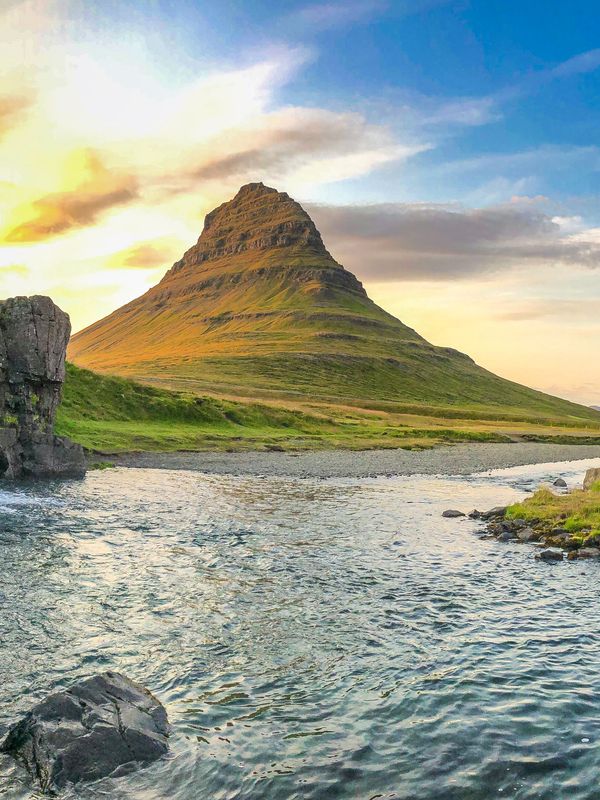
Discover Kirkjufellsfoss Waterfall, A Gem Near Kirkjufell Mountain
If you’re planning a trip to Iceland, Kirkjufellsfoss should be at the top of your list. Located on the northern side of the Snæfellsnes Peninsula, this beautiful waterfall, with the famous Kirkjufell Mountain in the background, offers one of the most scenic and unforgettable experiences in the country.
Key takeaways
- Kirkjufellsfoss is a 16-meter tall waterfall with three separate cascades, located on the Snæfellsnes Peninsula.
- It's easy to reach, just a 2.5-hour drive from Reykjavik.
- The waterfall is part of the Kirkjufellsá River, which changes in size depending on the season.
- The area around Kirkjufellsfoss is full of fossils, showing the volcanic history of Iceland.
Why Is Kirkjufellsfoss Worth a Visit?
Kirkjufellsfoss is more than just a waterfall; it looks like something out of a fairytale. With its three small waterfalls, the river Kirkjufellsá, and the impressive Kirkjufell Mountain in the background, it creates a stunning view that's perfect for photos. This special scenery makes Kirkjufellsfoss one of the most photographed places in Iceland.
Besides its beauty, Kirkjufellsfoss is easy to get to, which makes it a great stop for anyone traveling around the Snæfellsnes Peninsula. Whether you love taking photos, enjoy nature, or just want to see the beauty of Iceland, Kirkjufellsfoss is a place you must visit. Plus, you can see the Northern Lights here in the winter, making it a fantastic destination all year round.

Kirkjufellsfoss Facts & Features
Kirkjufellsfoss is a beautiful waterfall with both natural beauty and an interesting history. Here's a simple look at what makes it special.
The Name and Its Meaning
Kirkjufellsfoss means "Church Mountain Falls." This name comes from the nearby Kirkjufell Mountain, which looks like a church steeple. The mountain’s unique shape makes the area very popular for photos. Together, the mountain and the waterfall create a stunning scene that shows off Iceland’s beauty.
The Waterfall’s Structure
The waterfall is 16 meters tall and made up of three smaller falls that join into one, making it look very interesting and beautiful. Kirkjufellsfoss is part of the Kirkjufellsá River, which flows from the mountain and adds to the lovely scenery.
Geological Significance
The area around Kirkjufellsfoss is rich in fossils, showing Iceland’s volcanic past. The rocks and landforms around the waterfall tell the story of the powerful natural forces that shaped Iceland over millions of years. People who like geology will find Kirkjufellsfoss a great place to learn and explore.
The River Kirkjufellsá
Kirkjufellsfoss is part of the Kirkjufellsá River. The river starts from Kirkjufell Mountain and flows down to create the waterfall. The amount of water in the river changes with the seasons. In spring and early summer, melting snow from the mountain makes the river bigger, which makes the waterfall even more impressive.
The Surrounding Landscape
In the summer, the area around Kirkjufellsfoss is green and full of life. In the winter, it becomes a snowy wonderland. Many plants and animals live in the area, making it a lively and beautiful place to explore. The changing seasons provide great photo opportunities and outdoor activities, making Kirkjufellsfoss a great place to visit any time of the year.

Where’s Kirkjufellsfoss and How to Get There
Kirkjufellsfoss is on the northern coast of the Snæfellsnes Peninsula, near the town of Grundarfjörður. It’s about a 2.5-hour drive from Reykjavik, around 180 kilometers away. To get there, drive on Road 54 towards the Snæfellsnes Peninsula and follow the signs to Grundarfjörður. The waterfall is easy to find and has parking nearby.
Directions from Grundarfjörður to Kirkjufellsfoss
- Head southwest on Eyrarvegur toward Grundargata
- Turn right onto Grundargata
- Continue onto Snæfellsnesvegur
- Turn left
What to Wear When Visiting Kirkjufellsfoss
When you visit Kirkjufellsfoss, it's important to dress for the changing Icelandic weather:
- Sturdy hiking shoes: The path to the falls can be uneven.
- Crampons: Good for walking on icy trails in winter.
- Layered clothing: Helps you stay comfortable in changing weather.
- Waterproof jacket: Keeps you dry.
- Hat and gloves: Keeps you warm.
- Water: Bring water if you plan to hike around the area.

Surrounding Sites & Things to Do
The Snæfellsnes Peninsula has many cool places to see and things to do near Kirkjufellsfoss. Here are some highlights:
Arnarstapi
A charming fishing village with beautiful coastal cliffs and interesting rock formations. Arnarstapi has a pretty harbor and walking trails along the coast with great views and chances to see local wildlife.

Djúpalónssandur
A black sand beach with remains of a shipwreck and unique rock formations. This beach is not only striking but also full of history, with large stones that fishermen used to test their strength.

Búðir
Visit the historic black church surrounded by lava fields. The Búðakirkja is a unique sight and a great photo opportunity, giving you a glimpse into the region's history.

Snæfellsjökull National Park
Home to the Snæfellsjökull glacier and various hiking trails, Snæfellsjökull National Park is famous for its beautiful landscapes, diverse plants and animals, and the glacier that inspired Jules Verne’s "Journey to the Center of the Earth."

Grundarfoss and Bjarnafoss
Other nearby waterfalls worth visiting. Grundarfoss and Bjarnafoss offer more hiking opportunities and beautiful scenery, making them perfect for a day trip from Kirkjufellsfoss.
Conclusion
Kirkjufellsfoss is more than just a waterfall; it's a symbol of Iceland’s natural beauty and a great starting point for exploring the Snæfellsnes Peninsula. Its easy access, stunning views, and nearby attractions make it a must-visit spot in Iceland. Whether you’re taking photos, hiking, or watching the Northern Lights, Kirkjufellsfoss will give you unforgettable memories.



